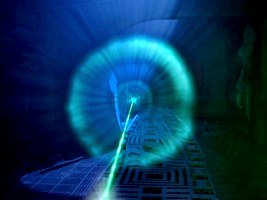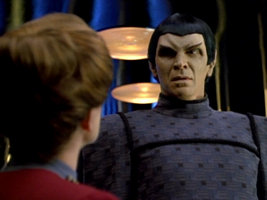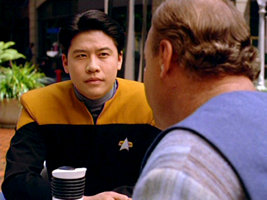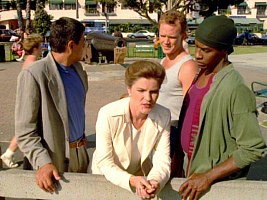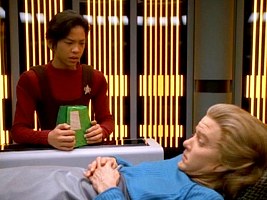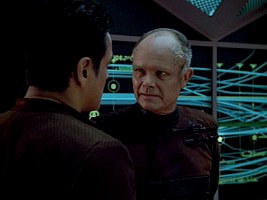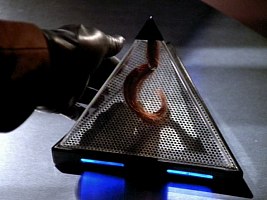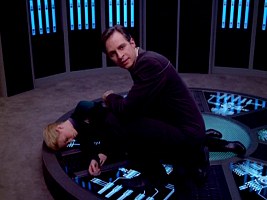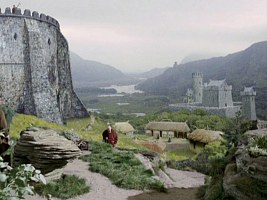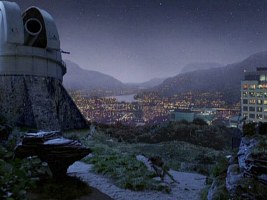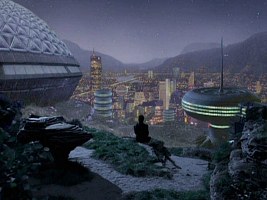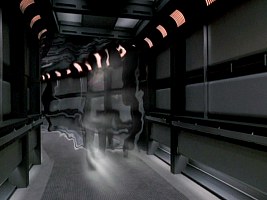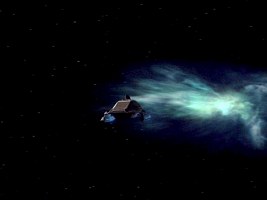Time Travel in Star Trek: Voyager (VOY)
"The past, the present and the future, they exist as one, they breathe together." (Annorax, VOY: "Year of Hell")
VOY: Parallax
Voyager receives a distress call and unintentionally gets trapped within the event horizon of a quantum singularity. Every alleged way out leads back to a place inside the event horizon, or, more precisely, Voyager actually does not leave this place, even when the ship seems to travel at warp speed. The second ship is identified as another Voyager, probably a "temporal reflection" from another time. Although there is no real time travel, predestination is implied, since the distress call from Voyager itself was the incentive to approach the black hole.
However, it is highly improbable that a quantum singularity or black hole has the shown effects, no matter if in Star Trek or in the real world. The event horizon is defined as the radius of a black hole inside which any energy or mass is definitely trapped, but only the basic idea of is used in this episode. The real effect of a black hole would be that for an external observer time stands still on a starship near the event horizon, while it becomes invisible as soon as it is inside. There would be nothing like a "temporal reflection". Besides, it is highly questionable if the SIF could compensate for the extreme gravity or space distortion near or even inside the event horizon. The above described hallucination effect that the ship seems to leave the event horizon is just too odd and deserves no further consideration. At least it is acceptable that Voyager can leave the event horizon by means of Treknology (dekyon particles in this case).
Classification: parallel time levels, with predestination phenomenon
VOY: Time and Again
Voyager arrives at a planet, the surface of which has been completely devastated by an explosion, and no life exists any more. Down on the planet, Capt. Janeway and Lt. Paris disappear through a subspace rift and arrive at a time prior to the explosion when the population is still alive. They learn about power plants employing polaric energy, which is connected with deadly risks. They join a group of people who plan to intrude into the power plant in order to protest against it. The planet is truly Earth-like. Not only do the inhabitants look exactly like humans, they also employ Arabic figures, and the anti-polaric demonstration is familiar too.
The surprising outcome is that not the manipulation of the power plant is the cause for the explosion, but the attempt to save Janeway and Tom through a subspace tunnel, which destabilizes the polaric power source. So actually the Voyager crew is unintentionally responsible for the disaster. This episode seems to be based on a predestined timeline, since the effect of the time travel is evident before the time travel occurs. However, if the timeline were really predestined, all events would be unchangeable, and neither the planet nor the two officers could be saved. Voyager would have to leave the devastated planet without Janeway and Paris, since they have died in the planet's past. Nevertheless, the timeline is changed and the explosion is avoided this time, and this is a clear contradiction to the above predestined sequence of events. Anyway, a new timeline emerges in which Voyager encounters an intact planet, and no one remembers the fatal original timeline.
Classification: broken predestined timeline ("causality loop")
VOY: Eye of the Needle
The wormhole in this episode leads to the Alpha Quadrant, and it is found that it also leads back to the year 2351. The Romulan captain Telek R'Mor is advised to keep his encounter with Voyager secret until the ship actually disappears, although he proposed to warn Starfleet. Captain Janeway insists on this agreement because Voyager is important for the history of the Delta Quadrant.
The possibility of a paradox is not mentioned in the episode. The Romulan captain probably kept his promise, and the timeline was not changed. Unfortunately Tuvok finds out that the man died in 2367 before he could inform the Federation about Voyager. In the alternative timeline in the episode VOY: "Non Sequitur" it is mentioned that there has been a memorial service for the Voyager crew. We can suppose that also in the original timeline after "Eye of the Needle" no one knows of the whereabouts of Voyager until the episode "Message in a Bottle".
Classification: interaction with the past, probably without consequences
VOY: Non Sequitur
Harry is still in the present, but it is obviously another reality in which he is not aboard Voyager, but in San Francisco where he is engaged in the construction of the Yellowstone-class runabout prototype. Tom too has remained on Earth. Harry learns that his Voyager shuttle got into a "temporal inversion fold in the space-time matrix", or simply a time stream, and this accident altered history.
So Harry is not in a parallel reality (such as Worf in TNG: "Parallels"), but in another timeline. Harry himself was obviously protected (a meanwhile familiar concept), and he is the only person to know about the old timeline. In order to get back to Voyager, Harry has to find the time stream and recreate the accident. The alien lifeform (Cosimo) tells Harry that the time stream weaves through the galaxy, so it can be reached with a runabout from sector 001. However, the alien can give him no guarantee of getting back, and Harry could find himself at any time in the past or future. Nevertheless, Harry and Tom manage to reproduce the accident, even with a damaged runabout and without any computer data, and Harry travels back to the exact instant when he caused the first timeline change. Back in the original timeline, Harry is saved from the collapsing shuttle and comes aboard Voyager, where he is the only person to know about the intermediate timeline. A person can hardly have more luck.
Classification: alternate timeline that ceases to exist
VOY: Death Wish
Quinn, the member of the Q Continuum who seeks asylum on Voyager, transfers the ship and crew to the Big Bang, a "very old hiding place". The journey remains without consequences. If there were any consequences, they would have to be extreme, and the whole universe ought to be totally different.
Classification: travel to the past, without consequences
VOY: Future's End
The small Federation timeship Aeon under Capt. Braxton appears from a space-time rift. Braxton pretends that Voyager will be responsible for an explosion that destroys all of Earth's solar system in his time, the 29th century. As a consequence, he has no other choice than to destroy Voyager prior to this disaster, or so he says. However, Voyager fights back against the technologically advanced yet vulnerable timeship, and both vessels are pulled into the space-time rift. The timeship probably came from Earth, or at least from a nearby region of space, since Earth itself was destroyed in this timeline. So it is no surprise that the space-time rift leads back to Earth. The time of arrival seems to be undefined, considering that the time travel is not controlled when the two ships enter the rift. While the timeship crashes down on Earth in 1967, Voyager arrives there in the year 1996. By the way, once at home, why does Captain Janeway not take the chance and travel to the 24th century the old-fashioned way, as Kirk & crew did three times?
In the year 1996, Braxton is nothing but a freaky old man. Anyway, he outlines the sequence of events: "A - There is an explosion in the 29th century. Debris from Voyager is found. I go back to the 24th century to stop you. B - Voyager prevents me from destroying you, destabilizing my equipment and throwing me back to the 20th century. C - Someone from the 20th century steals my timeship and launches it. It goes back to the future, but makes a critical mistake that launches a temporal explosion...and we jump back to A." In other words, Braxton explains a causality loop in a predestined timeline.
The Voyager crew learns that Henry Starling, a former hippie who was camping near the crash site in 1967 seized Braxton's timeship and used the technology to initiate the microelectronic revolution. It is debatable if contemporary technology can be derived from very advanced components. There must have been a detailed instruction aboard how to produce "antique" microchips that fit into history. In this respect, Starling had only a slight advantage over his competitors. Moreover, it would probably not help him to go to the 29th century to get more technology he cannot use directly. So why does he take the risk anyway, even after he has been told that it might lead to a disaster?
It is worth mentioning that in the real world the company Intel was founded at about the same time (1969) and started the microelectronic revolution with the introduction of the first integrated memories and the first microprocessor. In the Star Trek universe Chronowerx (note the allusion to the origin of Starling's technology and the 29th century comm badge logo) took Intel's and other companies' places. Janeway notes that the microelectronic revolution at the end of the 20th century should not have taken place. She obviously read about this era in a history book or PADD, and now she gets to know that it all happened because of a time travel. This also points to a predestined timeline.
The destruction of the timeship with Starling aboard should have lead to a paradox, since this definitely breaks the predestined timeline. Nevertheless, a final timeline emerges in which the future is changed, but not the past, as if there were no causality. This solution is not logical and therefore not satisfying. Moreover, a browser called "Browser Hound" by the company Chronowerx shows up in VOY: "11:59", although the impression is created that Starling's rise to an industry tycoon will not happen in the final timeline. Also, it is mentioned in VOY: "Relativity" that Braxton (or one version of him) actually spent all the time in the 20th century, as if the timeline had not been repaired.
Classification: multiple time travels, incorporating broken predestined timeline ("causality loop"), outcome uncertain
VOY: Before and After
The oddity about the repeated time travels in this episode is that Kes travels back into her own (and younger) body each time, so it is not a solely physical, but also a biological problem. Any attempt to explain this phenomenon is very hard, since it is not just a matter transfer, but Kes's consciousness is transferred from one time to another. This raises the question what a consciousness really is and how it can be removed or replaced. Moreover, what happens to the consciousness of the younger Kes who is replaced by the older one each time? Picard has similar experiences in TNG: "Tapestry" and TNG: "All Good Things", but his time travels are arranged by Q, and it is not clear whether they are completely real.
Kes starts traveling back in time when the EMH puts her into the biotemporal chamber at the end of her life at the age of 9. In conjunction with the chroniton contamination, from which she suffers since the Krenim attack a few years earlier, this treatment is the cause for her time leaps. Kes's actions in the present appear to have no effect on the respective future. Otherwise the Doctor, who knows about the time leaps, and also Kes herself could simply avoid the biotemporal treatment in the future and therefore cause a paradox. Yet, it is not clear what will happen in Kes's future after she has traveled back and if she will have a future at all. Each time Kes arrives at an earlier time and tells what she is going through, the Doctor attempts to stabilize Kes's condition and keep her in the respective present. The question arises if this is really necessary and if it makes sense at all. After all, there was another Kes in the respective present before the Kes from the future took her place. On the other hand, we have visual evidence of Kes vanishing in the eyes of everyone else whenever she leaps to an earlier time. This seems to indicate that Kes won't exist any longer in the future. So there is a risk that as soon as the future Kes is further in the past, Kes will disappear in the present and future. In this case Kes will finally cease to exist as a living being once she reaches an instant before her procreation. This possibility is briefly hinted at in the episode.
The Doctor's repeated attempts to stabilize Kes finally succeed in the "present", i.e. at the time between the previous and the following episode. Nevertheless, Kes is shown traveling back even to an instant prior to her birth, while she is simultaneously in sickbay. This could be the decisive hint what happens when Kes has gone for another time leap. Her body in sickbay might remain unconscious without a chance that consciousness is ever regained, since it is on a time travel. It is not consistent with Kes vanishing earlier in the episode though.
Furthermore, it has to be mentioned that it is the Kes from the future who remains in the present at the end of the episode. Due to the strange cerebral decay, which is being reversed while she travels back in time, she only remembers part of her future, and it is questionable if she remembers many things of the present and past. Anyway, she is not the same person that she was earlier at this age. However, this seems to be no problem in the following episodes.
Side note It is noticeable that Kes suddenly has long hair in the present. This is definitely not attributed to her time travels, since not her body but her consciousness is traveling.
At the end of the episode, Kes tells about the (possible) future, and Tuvok is obviously interested in getting to know more about the Krenim. Nevertheless, at the very time of the first Krenim attack in VOY: "Year of Hell", all of Kes's knowledge of the future is gone. Neither Tuvok nor anyone else remembers what Kes told about the Krenim and their chroniton torpedoes, and of course there is no defense against them. This could be regarded as another inconsistency, unless it is taken into account that in "Before and After" Kes travels back from a future that ceases to exist at latest when she leaves the ship in VOY: "The Gift". In other words, all events that have been shown in "Before and After" actually never took place or will never take place in the new timeline, when Kes is not aboard Voyager. The question remains how Voyager could make it through Borg territory in the original timeline without Kes leaving the ship and pushing it 10,000 light years towards the Federation territory. Vice versa, in the old timeline Seven of Nine is not there to help the crew in several critical situations. Notwithstanding these significant differences, in both timelines Voyager encounters the Krenim at about the same time.
Classification: "biological" time travel
VOY: Year of Hell
"Year of Hell" does not exactly feature time travels, but "temporal incursions". Although the principle of temporal incursion is not sufficiently explained in the episode, the impact is discussed or becomes evident several times. The Krenim scientist Annorax designed the incursion device with its temporal core and the weapon ship on which it is installed in order to turn it against the enemies of his people. Annorax's first incursion made the Krenim powerful again. Fate turned against him when he unintentionally eradicated his family with the second incursion, and this makes him a tragic character, rather than a simple villain ("You're a long way from home, and in a manner of speaking so am I").
The temporal incursion weapon is focused on a target object, which is then removed from our space-time. Not only will the respective object disappear in the present, but also in the past and future. In other words, the target has never existed in what we regard as our history. The question where the target object exists after the incursion, if not in our space-time, is not answered, however, this is of minor importance for the further discussion of the episode. How can the effect of temporal incursion be accomplished? The first possibility is to trace back the object's history and continuously or frequently remove it from space-time, which corresponds with Annorax's statement: "I can control the destiny of a single molecule or an entire civilization". Still, the probability to get the right trace in a time many millennia ago, let alone back at the instant of the Big Bang, is virtually zero. After all, this method justifies the extremely complex calculations that are necessary for an incursion. The second method implies a kind of "anti-time" reaction similar to the one featured in TNG: "All Good Things". Once applied to the object in the present, the incursion wave travels back to the past and continuously erases the object. In this case the calculations are necessary to simulate the effect and not to control the weapon itself. However, their complexity is probably the same.
Eradication of the target itself is the primary effect of temporal incursion. Apart from this, the disappearance of the respective object will entail more or less severe consequences, which can be regarded as secondary effects. For instance, the comet Chakotay proposes to erase in order to alter Voyager's course in the past carried organic molecules that allowed the formation of life on a planet. The inhabitants of the planet finally colonized many sectors of space. Erasing the comet would cause 8000 civilizations within 50 light years to disappear. This is where temporal incursion is equivalent to time travel, and where paradoxes may occur. In other words, temporal incursion is similar to traveling back to ancient times, removing an object and taking it along to the future, with all potential consequences. Taking into account all possible secondary effects, Annorax calculates a "focal point" each time at which the weapon is directed. In this way it is not necessary to destroy a whole planet, but only some decisive man-made objects in order to eradicate the whole civilization on the respective planet and leave nature intact. This is shown in several VFX sequences, and it is noticeable that primary and secondary effects cannot be distinguished, since they become evident simultaneously. It remains Annorax's secret how he gathers all the necessary information from the past. The data volume must be incredibly high.
The sequence of events is probably the most complicated ever shown in Star Trek. The following table provides a survey of the temporal incursions that have been shown or mentioned in "Year of Hell":
| Time | Incursion # | Goal | Target | Effect |
| Some 200 years ago | Original timeline | - | - | The Krenim wage war against several enemies. Annorax builds his weapon ship to eradicate the enemies and make the Krenim powerful again. |
| Some 200 years ago | 1 | Restoration of Krenim Imperium | Rilnar Homeworld | The Rilnar, enemies of the Krenim Imperium, are erased, and the Krenim become much more powerful. However, an antibody that the Rilnar have introduced disappears as well, and 15 million people die of a disease for which there is no cure in this timeline. |
| Some 200 years ago | 2 | Unknown | The primary effect of this incursion is unknown, anyway, the remote outpost on Kyana Prime is erased as well together with Annorax's family. | |
| During the last 200 years | 3..x-1 | Restoration of Kyana Prime Colony | Numerous | The Krenim Imperium is never completely restored, neither is Kyana Prime. |
| Day 1 | x | Zahl outpost | A Zahl outpost is erased, which has minor bearing on the timeline, and the Krenim territory remains small. Voyager encounters a harmless Krenim patrol vessel. | |
| Day 4 | x+1 | Zahl homeworld | The Zahl Homeworld is erased, which leads to a 98% restoration of the Krenim Imperium (849 worlds, 5000 parsecs in diameter), but Kyana Prime is not re-established. Voyager is now under attack by a powerful Krenim warship. No one aboard notices the timeline change. | |
| Day 65 | x+2 | Garenor homeworld | The Garenor Homeworld is erased, but Voyager's temporal shields interfere with the temporal shockwave such that the Krenim Imperium is reduced to a few planets. This time the Voyager crew is aware of the timeline change. | |
| Day 70 | None | Eradication of Voyager | USS Voyager | Annorax attacks Voyager with his weapon, since the eradication of the Federation ship would probably lead to the desired effect of incursion #x+2. However, Voyager's temporal shields hold. |
| Day 207 | x+3 | Restoration of Kyana Prime Colony | Ram Izad homeworld | The Ram Izad civilization is erased, which entails a 52% restoration of the Krenim Imperium. |
| Day 257 | x+4 | Eradication of the attacking fleet | Two Nihydron vessels | The incursion beam penetrates the temporal shields, and the vessels are eradicated. |
| Day 257 | x+5 | Restoration of original timeline (Janeway) | Janeway rams Annorax's ship | A temporal incursion within the weapon ship occurs, so the ship erases itself. Since the ship has never existed, history is reset to a state that was prior to the first incursion. Nevertheless, this timeline is different from the original one. |
A temporal shielding serves to protect Annorax, his crew and ship from the impact of temporal incursion and to avoid paradoxes. This is necessary, since any incursion Annorax carries out in order to restore the Krenim Imperium will almost certainly lead to a situation in which the incursion ship is not needed and will never be built. Second, even if the existence of his ship itself is not impaired by the incursion, Annorax would not be able to "enjoy" the effect he has achieved, if he is affected himself by the timeline change and does not notice it. The shielding implies that his ship is out of our space-time. Nevertheless it is visible. Maybe its principle is similar to the chroniton particles that protect the Defiant in DS9: "Past Tense". The question arises whether the shielding is necessary only during the incursion or all the time. In the latter case Annorax and his crew would have to stay aboard for all future in order not to be affected by the timeline change, which would not be very pleasant for them. When the fleet attacks the weapon ship on day 257, first officer Obrist turns the temporal core offline which causes the temporal shielding to fail. Annorax notices that the ship "is phasing back into normal space-time", which indicates that this is a continuous process, but it does not become clear in which way the crew is affected by this process. If the shielding is necessary all the time in order to preserve the old timeline within the ship, it is self-evident that the lock of hair of Annorax's wife disappears, since she has never existed in the timeline outside the ship. In this case, however, Annorax, his crew and ship who do not belong to the external timeline as well should have vanished at the same time. Still, the ship eventually disappears as late as it is erased through self-incursion after Voyager has rammed it. While the nature of the weapon ship's shielding is not clear, Voyager's temporal shielding can obviously be turned off without the crew and computer forgetting the old timeline.
It is stated that Annorax and his crew have been spending some 200 years aboard their ship. He also claims: "As long as we are on this vessel, protected from space-time, we have all eternity to accomplish our mission." Nevertheless, irrespective of temporal shielding and other effects, if the crew have experienced and measured 200 years, they must also have aged accordingly, unless the shielding implies unknown biological effects that prolong life. The only explanation for this phenomenon is that the Krenim are a very long-lived species.
The temporal incursion propagates in the form of a temporal shockwave that implies a discontinuity of timelines. The new timeline applies to the region the shockwave has already passed, while the old one is still existent in the region in front of the wave. The shockwave is obviously a subspace phenomenon and travels at warp speed, since it would otherwise take many years before the effect becomes evident in a distant region of space e.g. when the Garenor Homeworld is erased, 20 light years away from Voyager. However, each time the weapon is applied to a target, as shown in the nice VFX scenes, the wave propagates at a speed that can easily be perceived with the eyes. The effect is obviously shown in slow motion to emphasize it.
The undetonated chroniton torpedo is located in the Jefferies tube on deck 11, section 2 in "Before and After" as well as in "Year of Hell", and is examined by Kes and by Seven of Nine, respectively. This is a very improbable coincidence, taking into account that the timeline was significantly changed when Kes left the ship and Seven came aboard. What's more, in "Before and After" Captain Janeway and B'Elanna die in the first Krenim attack, whereas in "Year of Hell" only "Ensign Insignificant" is killed. The fact that the chroniton torpedo has the same temporal variance of 1.47 microseconds each time is not necessarily a coincidence, since this might apply to all torpedoes.
On day 1, Voyager encounters a Krenim patrol ship or warship three times in three different timelines. The Krenim commander is the same person each time, which is not a sign of consistency but highly improbable. At least, in the final timeline, the encounter takes place before the astrometric lab is presented, whereas it has been afterwards in the first two versions.
The scene in which Voyager rams the weapon ship is connected with a number of problems. First, Janeway must be very desperate to hope that destroying the weapon ship will lead to a self-incursion, yet she seems to be sure about it ("Time's up."). She should have taken into account that even if Annorax's ship survived the probable explosion of Voyager's warp core, the temporal core would be too heavily damaged. Second, the temporal core is not working any more at this time, since Obrist took it offline, nevertheless it causes the self-incursion. Third, if a temporal incursion within the ship erases the ship together with Annorax and his crew, they will not exist any more in the new timeline, since this is what happened to all objects that have been eradicated before. However, at least Annorax does exist in the final timeline, and this fact leads to a paradox. If the original timeline prior to the first incursion is restored, Annorax will certainly build his ship again and all history will repeat, leading to a causality loop. In this case Voyager could not escape as well and would be destroyed each time ramming Annorax's ship. Nevertheless, the timeline shown at the end of the second part is definitely different from the one in which Voyager and Annorax destroy each other, since the first encounter with the Krenim patrol ship is prior to the demonstration of the astrometric lab this time. It is still possible that Annorax carries out temporal incursions in this timeline as well, and might affect Voyager. It becomes evident as late as in the following episode that the "Year of Hell" does not occur all over again.
In this context the final scene of "Year of Hell" is the most ingenious ever seen in Star Trek. Not only does the scene show Annorax together with his beloved wife, whom he tried to get back for 200 years and actually got back when he was defeated. The scene also leaves multiple possibilities of interpretation what is actually happening. The scene could show Annorax making his first calculations some 200 years ago, which could be a sign that he is about to build the incursion weapon and history will repeat. Or the fact that he drops the PADD with "a few more calculations" in order to care about his wife could be a sign that he is more sensible this time. Or the scene could take place in "our" present, i.e. at about the time when Voyager passes Krenim space. In this case it is obvious that history was altered and Annorax had a lucky life together with his family. Still, his PADD indicates that he might build his ship, fortunately too late to affect Voyager.
Classification: multiple past incursions to change history, without physical time travel, corrected
VOY: Timeless
The attempt to get Voyager home using the newly installed quantum slipstream drive turns into a disaster. The ship drops out of slipstream, runs out of control and crashes onto an ice planet. The crew is killed, except for Harry and Chakotay aboard the Delta Flyer who remain in slipstream and finally reach Earth. Fifteen years later, the two officers try to alter the past. They steal the Delta Flyer and a Borg temporal transmitter to send a message to Seven of Nine in the past, consisting of new course correction data to keep the ship in the slipstream. The attempt, however, fails and the ship is nevertheless destroyed. Time is pressing, since the Delta Flyer is pursued by the USS Challenger commanded by Capt. Geordi La Forge, who has been ordered to prevent the violation of the Temporal Prime Directive under all circumstances. Without the knowledge how to maintain a stable slipstream flight, Harry decides to send new data back to the past to collapse the slipstream, in order to save the crew's lives at least. This time he succeeds. Seven receives the message, the slipstream is shut down and the ship is safe in the past.
The Delta Flyer explodes due to a warp core breach just after the message to the past has been sent, indicating that the respective timeline continues for at least a few seconds. This timeline, however, is supposed to disappear immediately, as soon as the past is changed, unless the transmission to the past is connected with a delay. It is obvious that there should be at least a delay due to the spatial distance, even if Borg subspace devices are employed. "Timeless" features the usual grandfather paradox, where the past is changed from a future that will eventually cease to exist. When Harry asks her to explain this paradox at the end of the episode, Janeway responds "Don't even try". I am not sure if this is a sign of wisdom or of ignorance. Anyway, it is a good suggestion in this case.
Classification: past incursion to change history, without physical time travel, successful
VOY: Gravity
One of Voyager's shuttles gets sucked into a gravity well and crashes on a desert planet. Tuvok and Paris are trapped on the planet for months while only a few hours elapse on Voyager. The problem is that, according to general relativity, time in a high gravity region should elapse slower and not faster than outside. On the other hand, the planet's gravity is obviously in the normal range, which points to something different than a relativistic effect. In other words, there must be a region of normal gravity embedded in the high gravity region. Therefore it should be rather one of the strange Trek phenomena made responsible for both the gravity and the dilation effects.
Classification: different time levels
VOY: Relativity
Calling this episode "complicated" would be a mild understatement. It's hard to analyze a time travel episode that consists of intricate paradoxes, but I will nevertheless try it.
1. "Relativity" begins at Utopia Planitia when Voyager is just being prepared for the first mission in 2371. Seven of Nine, disguised as a Starfleet ensign without Borg implants, is supposed to detect the temporal disruptor that will destroy the ship about four years later. She has been hired by Capt. Braxton from the 29th century, who wants to examine the accident. Although it was not explicitly stated, I think his motivation is not to rescue the ship in the first place, but the temporal device comes from his time and would be a violation of the Temporal Prime Directive that has to be prevented.
Seven creates the first potential paradox when she meets Captain Janeway and Joe Carey. What might happen if they recognized her when she comes aboard in "Scorpion" and her human physiology is restored in "The Gift"? Their actions in the future might be considerably different, and Braxton's crew might not be able to beam out Seven in the first place in 2375. It is not a predestination paradox, since Janeway definitely doesn't know Seven in "The Gift", so the future is actually in danger.
Seven is obviously able to see the temporal device, which is not only out of phase but not even in place yet as of 2371. I wonder how she can see into the future which has never been mentioned so far. Anyway, this scene is a clear mistake, since she can't perceive the device during the Kazon attack (see act 2) in 2372.
When Seven returns to the 29th century, she dies on the temporal transporter platform. Too bad. However, Braxton, has a simple solution just to retrieve Seven once again. His assistant says they have already used her before, and that a forth jump would cause "neural damage, even temporal psychosis". The accumulative damage is obviously a trick to increase the thrill of time travel, however, it makes no sense. Every time Seven is going to be drafted again, it has to happen a bit earlier, and the "fresh" Seven wouldn't have been damaged before. They would only need to take care that the same copy of Seven is not transported too often.
2. This act begins in the present, i.e., the time prior to the explosion of the ship in 2375. There are a few "minor" effects, for instance the ping-pong ball that stands still. There are supposed to be some paradoxes too, the most obvious being the Doctor's premature arrival in the mess hall, before Neelix actually calls him. The paradox is that after the Doctor has already arrived there is no need to call him in the first place. BTW, why didn't the Doctor try to call himself, just for fun? :-)
Back in the Jefferies tube once again (or the first time from her point of view), Seven can see the device, which is out of phase but actually there. Just before the ship explodes, two crewmen of the Relativity appear and transport her to the future. I wonder what Braxton meant by "retrieve Seven of Nine a microsecond before the explosion". The two men can hardly have such a precise timing. What's more, I wonder how they got hold of Seven the first time. Shouldn't there be two other men also waiting for her? What about this paradox: By getting her a second time, wouldn't they prevent the first time from happening?
Anyway, Seven is now being prepared for her next mission. She learns that she has done this already twice before. So there was a mission 1 we haven't seen and the aforementioned fatal mission 2. Obviously the forth time that becomes dangerous is supposed to refer to the complete mission, which consists of up to four transports altogether (2375 to 29th century, 29th century to destination and back, 29th century to "re-integration" - unless she is dead by then).
There is a mistake from the part of Seven of Nine when she is supposed to give an example of the Pogo paradox aka predestination paradox, "a causality loop in which interference to prevent an event actually triggers the same event". She refers to the events of "First Contact". However, there was no predestination involved, since Earth was definitely assimilated when the Borg had vanished to the past, which would not have been the case if their failure had been predestined. If there was a causality loop, it could have been as well that the Enterprise tried to prevent assimilation of Earth, but unintentionally helped the Borg doing so. ;-)
This time Seven is transported to the year 2372, or to be very precise, stardate 49123.4621. This corresponds to the early second season, prior to "Maneuvers". As already mentioned, she can't detect the device now, which is no surprise, since it's not yet there. Therefore it becomes a mystery why she could see it at Utopia Planitia. When Janeway and Tuvok contain her inside the forcefield, it's the usual "I'm from your future" game and if the encounter at Utopia Planitia wasn't already a paradox, this is definitely one, and Braxton is not very happy about it.
The story becomes really weird when the second Braxton appears. This Braxton is supposed to be older than the one on the Relativity, so the latter can't know about him. So far, so good. Yet, old Braxton claims he has actually experienced the 30 years on 20th century Earth, as it was shown in "Future's End". This statement left me baffled. Didn't Braxton show up at the end of the episode and he was all right? Agreed, this was obviously a younger version who might *not yet* have experienced this timeline. Yet, the impression was created that the complete sequence of events, including the encounter with Voyager, Braxton's crash on Earth, Starling's flight to the 29th century and the disaster in the solar system, were extinguished at the very moment when Voyager destroyed Starling's stolen timeship. If this was not sufficient, the young Braxton that was obviously able to scan time should have found a means to prevent his unintentional stay in the 20th century from happening. Even if the timeline of 20th century Earth wasn't changed, was the old Braxton rescued from this time by his colleagues? This is actually the only reasonable explanation, I only wonder why they needed 30 years. This could be the case if there was already a Braxton in the 29th century, and the one in the 20th century was just forgotten - how thoughtless. After his return the two were probably re-integrated, and the memory of the 20th century eventually prevailed. On the other hand, there should be two versions of the 29th century: one in which Voyager was destroyed and Braxton is more or less successful in his job (as shown on the Relativity) and one in which a (future) Braxton sees a need to destroy the ship which has not happened until then. Now it's really getting too complicated: another paradox within the paradox. In my diagram the "Mad Braxton" timeline and the main timeline should be tied together in some way, but I didn't know a solution, so I kept them separate.
3. Seven is transported again, and it's allegedly her fourth time, just when it's supposed to become dangerous. As already mentioned above, I can't reproduce the strange mathematics of accumulative damage through time travels, so I won't comment on it. Anyway, Seven is now running through the corridors of Voyager at Utopia Planitia and shooting at Braxton, and is causing a hell of a paradox, but without obvious consequences.
4. It's now the fifth transport, if we still believe it. In 2375 Seven meets Seven and a couple of other crew members enjoying a table tennis match, just a second before the set point with Paris's inimitable "still ball" trick. Braxton is arrested, the case can be closed. Really?
5. It is now up to Janeway to clean up the timeline and prevent everything from happening in the first place (maybe she should go back to the Big Bang, then ;-)). Anyway, she has to stop Braxton once again, before he can install the bomb on Voyager, and I have another problem. This would be the ultimate paradox, unless the timeship is shielded against changes in the timeline, and even this would not sufficiently solve the problem.
Anyway, we get to know that different individuals who were separated by the creation of different timelines can be re-integrated. This is a rather elegant solution to the problem what to do with persons from extinct timelines. And it is somewhat similar to what was done with Capt. Christopher in TOS: "Tomorrow is Yesterday".
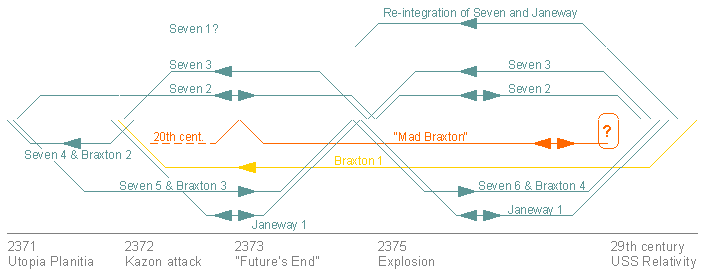
Not a track plan, but a summary of time travels in "Relativity"
The diagram shows the sequence of events in "Relativity". Every time travel is supposed to create another at least slightly different timeline. The diagram shows only the three main timelines. If it were more detailed, it would not only be unreadable, but would also reveal that persons would frequently travel to timelines that don't exist anymore, in other words, the paradoxes would show up in the form of countless question marks.
Classification: multiple past incursions to change history, corrected, involving "temporal re-integration"
VOY: Blink of an Eye
This adorable episode shows how a planet on which time passes in a blink of an eye interacts with the rest of the universe, and with Voyager in particular. So it's not really a time travel, but something closely related. The issues with story logic and visualization are essentially the same as in TOS: "Wink of an Eye" and TNG: "Timescape", regarding the frequency shifts that occur with every transition from one timeframe to another. Some problems of this specific VOY episode were unavoidable to build the plot, but some others were a bit careless.
First of all, a planet spinning at 58 revolutions per minute is not likely to maintain its cohesion for long - unless gravity is immensely high which would forbid any life on the planet or unless there is an effect involved that needs some technobabble to be explained. The latter seems to be the case here, and the tachyon core of the planet might be responsible for its strange behavior as well as for the fact that Voyager is stuck in its orbit. This leads to the next question: Did Voyager cause the temporal differential or was the planet always so "fast" compared to the rest of the universe? The statement saying that the tachyon core has created the differential is not definite. If the planet had always been out of time, this would explain why it is revolving so fast as seen from a distance. Yet, it would be an exceedingly unlikely coincidence that Voyager arrives the very week when the civilization is developing both iron processing and warp drive. If Voyager caused the differential by becoming the third pole, the planet would return to the normal timeframe as soon as the ship left. This, however, does not seem to be the case at the end of the episode when the astronaut Gotana-Retz says: "I'm afraid it'll be a while before my people actually join the rest of the galaxy." What would still hinder them, considering they now have all the required technology?
A related question is how there can be day and night and even seasons on the planet. If the central star is similar to our sun and the planet's orbit is similar to Earth's, one round would take millennia. If life on the planet has always been accelerated, this means that some other effect than a tilted ecliptic must be responsible for the seasons. If Voyager had caused the time dilation, most life on the planet would have probably perished after a while. The arguments concerning day and night are similar. The planet spins at 58 rounds per minute, which would allow a reasonable day-and-night period only if time itself were equally accelerated. The rotation rate of the planet perfectly complies with one of the contradictory figures given for the time differential (see table below). This can't be a coincidence. If Voyager were responsible, then life with days that last only a second would have been very strange before Voyager's arrival. So it is almost safe to say that the planet was always that fast. It's hard to explain physically, but logically it's necessary.
Like in the above TOS and TNG episodes, the frequency shift inconsistencies are obvious. The blue shift of radiation and radio messages from the planet is more or less consistent, neglecting some quantitative errors. Vice versa, however, Voyager would not be visible, but would appear extremely red-shifted on the planet. If at all, the people down there could make up merely a weak heat radiation source. The only way that Voyager's visibility could be explained would be that some ultra-high frequency radiation from Voyager's shields is converted to visible light. The problems concerning life on the planet become worse when we take into account that the radiation emissions from their central star are red-shifted too. If the star is similar to our sun, only a weak heat radiation would arrive on the planet, hardly enough to maintain life, let alone provide daylight. The only explanation is that the star is emitting very large amounts of x-rays, which appear like a normal solar spectrum on the planet. Even if we can explain this, there is no excuse that the two astronauts can see anything aboard Voyager and even feel that B'Elanna's hand is warm (which should have a temperature slightly above 0K in their timeframe). It was a bad idea anyway to let the two astronauts remain in their timeframe for a few minutes after they have entered Voyager, for which there seems to be no reason. We could make up a theory that the masses of their ship and their bodies "drag" some of their space with them (which might also explain that they are able to break through Voyager's shields), but this neither complies with real physics nor with Trek science as shown so far. In addition, the capsule did lose contact with their control center already while approaching Voyager, insinuating that they were already slowed down at that time. The dizziness or even trauma when entering another timeframe, on the other hand, is consistent with the two other Trek episodes that feature different time levels.
Many figures concerning the time dilation are stated in the episode, and there are a few embarrassing calculation errors. Maybe I should create a little pocket calculator tutorial for the Trek writers, especially conversion from decimal to hours, minutes and seconds. This is a short summary of the figures:
| Statement | Ratio (planet time / Voyager time) |
| Planet rotates at "approximately 58 revolutions per minute". (Tuvok) | 83,520 |
| "For each second that passes on Voyager, nearly a day goes by on the planet." (Seven) | 86,400 |
| "When it reached our time frame the frequency would be thousands of times higher than normal." (Chakotay) | > 1,000 |
| Time passed on the planet from receiving the message to the senior staff meeting: "nearly a century by now." This would mean it took a full ten hours to call for the meeting. | - |
| "I'm keeping you down there for three seconds, Doctor. That will be almost two days in their time frame." (Janeway) | < 57,600 |
| The Doctor remained on the planets probably for several minutes, which was over three years to him. This is consistent if it was about 18 minutes, but it seemed less. | - |
| "The sensors detected an early test." Four seconds period. "Another test - six weeks later." (Seven) | 907,200 |
There is one question that still bugs me: Why doesn't Gotana-Retz return sooner to the planet? One hour would equal about one decade. He might have the chance to see his friends and relatives again, but he spends a lot of time talking to Janeway, until he is finally "allowed" to leave because the ship is in danger. Finally, at the end of the episode we see an old man watch how a star disappears from the sky. I am pretty sure this is Gotana-Retz, but how is this possible, considering that Voyager should already be gone for many planet years? Well, he may have returned, and while Voyager was still undergoing repairs for one hour, as mentioned in the episode, he may have aged accordingly on the planet.
Classification: different time levels
VOY: Fury
There is an obvious grandfather paradox in this episode. Old Kes goes back to the past to betray her old crew to the Vidiians and to save her younger self. She is killed there. Janeway, Tuvok and, last but not least, young Kes herself keep the knowledge of this incident. When old Kes is about to travel back again, Janeway can convince her to stay in the present. I think the logical issues of the story is not so much the paradox itself, as we have encountered it countless times before, but the fact that Kes's time travel and the Vidiian attack have no effect at all on the present. Most notably, Kes doesn't learn anything from it. As if nothing had happened, she evolves to the very same bad old Kes for a second time, who, at the very same time (just after Janeway has replicated Tuvok's birthday cake) pursues the very same revenge plan. This can't be simply handwaved by something that wiped out her memory, since even then she would behave differently. Moreover, when she is talking to Janeway at the end of the episode, it is obvious she does remember everything indeed.
Coming back to the grandfather paradox, in the logic of the story, the presence of old Kes in the past and the Vidiian attack apparently really happened, although it is the consequence of a time travel that does not take place in the revised future. All in all, it would have been an equally valid and somewhat more credible resolution if Kes had changed her mind all by herself.
Classification: past incursion to change history, corrected
VOY: Shattered
So we have a ship that is split into 37 (not 47 ;-)) sections, and each of them is in another time. At first it is only Chakotay, who is able to cross the barriers between the frames. So far, so good. The key question is if the ship as a whole is intact or if there are only certain sections existent in certain times. In the first case, if the ship is intact at every time and in every place, it would be only Chakotay's special chroniton inoculation that makes him cross the barriers that, for some reason, can be found in certain locations on the ship. This would be a bit like in DS9: "Visionary" where there was something special about O'Brien, and some other effect (from the cloaked Romulan ship) caused him to jump ahead in time, and also TNG: "Parallels" where Worf entered different quantum universes, triggered by Geordi's VISOR. We could explain the whole mess in that Chakotay is just running through time, and it is actually him who is screwing up everything in the first place. This is regrettably (with regard to logic) not the case, as is pointed out in the episode several times, so we have to go with the very implausible alternative.
According to what is stated in the episode itself, the ship is split into different time frames, and in each time frame only a fraction of it exists. This is evidenced by Seska who states that they are not able to leave engineering. Another hint is that Seven can't be found in Naomi's and Icheb's future time frame, and she is supposed to be in another one. Actually, every person can be found uniquely in one time frame, but this is still another problem to be discussed. Another reason why the ships in the single frames are not intact, even before Chakotay's interference, is that Janeway tells Chakotay of malfunctions before Voyager is entering the Badlands that didn't occur in "Caretaker", so history was already changed. Finally, everyone, even Seska, sees the need to fix the whole mess, so in every time frame it has been noticed there is something wrong with the ship.
This is where the logical problems really start. It is quite obvious that a ship of which only a part exists in each time should have malfunctions - this term being a mild understatement, for most of the ship in most times should be without power and maybe without life support. Nothing physical can cross the barrier, be it a person or a communicator signal, so why is the ship in almost perfect shape in every time frame? And while everyone is talking about what is going on inside the ship, what is happening outside? Is the whole ship with its different time frames in one place and time in the universe, preferably at its last position prior to being hit by the anomaly? What has happened to the ship at Seska's time, for instance in this case, if part of it is not there any more? It seems much more likely that each section in its respective time and place and, the other way round, the other Kazon can't get into engineering just like Seska can't leave it.
The next problem is that Chakotay is able to leave engineering, and when he does, Seska and the Kazon can't see him any longer, but he can still see them. We know that there is something special about Chakotay, and when he can cross the barrier, it is somewhat plausible that he can look through it too. The actual problem is that Seska (or the camera showing the scene from Seska's view) can see anything of the upper level of engineering. What she sees can't be in Chakotay's time frame because why should she be able to perceive the environment, but not him, so it must be Seska's own time frame. But isn't it that she is confined to a certain area? The same applies to the officer who was with Chakotay and Janeway, and who can see the rest of the corridor in which the two have just vanished. The only explanation left is that somehow the time frames have no sharp edges, but they overlap a few meters. Also, just before Chakotay leaves engineering for the first time, a Kazon gun is thrown through the barrier. So other people or objects are able to cross it too, or is it only because Chakotay touched the gun? On the other hand, his medikit doesn't go with him when he first crosses a barrier. In addition, Janeway says that her helmsman (Lt. Stadi) "disappeared when she tried to walk down that corridor." Where is she, still in the same time frame, and just no one bothered to search for her, or in another time frame just like Chakotay? If the latter applies, why isn't every person able to cross the barrier (which would have caused *a lot* more confusion). The "Macrocosm" virus that pursues Chakotay and Janeway in the corridor obviously doesn't make it into their new time frame, so when they see it run into the barrier, it may actually bounce off and we only don't get to see how it goes back - or does it disappear, like Stadi, to some unknown third place?
The final problem, as already mentioned, is why each person only exists in exactly one certain time frame:
- Just before entering the Badlands in "Caretaker" - bridge - Janeway, Harry
- Just after the events in "Caretaker" - transporter room - B'Elanna
- During "Basics" - engineering - Seska
- Early 3rd season - sickbay - Doctor
- During "Macrocosm" - corridor - no one special
- During "Scorpion" - cargo bay 2 - Seven
- Mid 4th season, possibly during "Waking Moments" - corridor - no one special
- In the present - mess hall - Tom, Tuvok, Neelix
- 17 years into the future - astrometrics - Naomi, Icheb
Agreed, this is somewhat plausible if only part of the ship exists in each time frame. If Voyager were intact at every time, Chakotay could meet any of the 150 crew members at any time, including himself. But if the ship is really split, why is it that coincidentally each person (at least each of the main characters) is in exactly one place and time frame? Harry and Janeway are on the bridge when the ship runs into the anomaly and they are again on the bridge in the time just before entering the Badlands, but all other crew members find themselves in a different place than before. So we may assume that when the anomaly strikes Voyager, it creates time frames at random, and therefore creates situations at random where any person can be in a timeframe or not. Following a simple probability assessment, we will likely find quite a few different people on the bridge (to whatever time frame it may be transferred), including Janeway, Harry, Tuvok, Chakotay and Tom. We may find another Janeway in her quarters, perhaps another Tom in the holodeck (why is it that the program was running alone?), and so on. On he other hand, the division of sections and time frames may be such that certain persons don't exist at all. If many of the time frames are before Seven came to Voyager, and accidentally there is no time and location (note the logical AND between them) with Seven in it in the rest of the ship she may not exist at all. And why is it that there is a time frame containing Seska and the Kazons, but none with Kes, who spent a lot more time on the ship?
Classification: multiple time frames, corrected
VOY: Endgame
The problem is the good old grandfather paradox, much like already in "Timeless". The only difference is that this time there is a physical time travel when Admiral Janeway comes from the future to change her past. She is successful and, besides taking Voyager home, the Borg suffer a disastrous defeat and the Federation now has knowledge of technology that shouldn't exist for another 27 years. With history so drastically changed, it is obvious that Captain Janeway wouldn't have to repeat Admiral Janeway's trip to the past 27 years later. Nevertheless, this seems to be exactly what the Borg Queen thinks when she strives to destroy Voyager while the ship is in the transwarp conduit. Maybe the Queen was delirious after she had assimilated the pathogen.
Classification: past incursion to change history, successful
Credits
Some screen caps from TrekCore. Thanks to D.V. for suggestions about "Blink of the Eye".






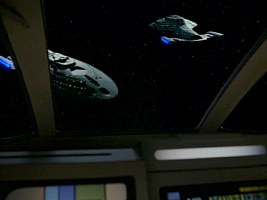
 Voyager in a black hole in VOY: "Parallax"
Voyager in a black hole in VOY: "Parallax"